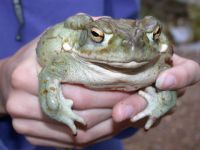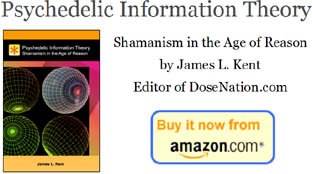Editor's Note: The following article appeared in Psychedelic Illumination 6 as a sidebar to a piece on toad licking. Check the citation at the bottom of the text to see where it was initially found.
There are several types of toxic substances found in toads, including cardioactive agents, catecholamines, indolealkylamines and non-cardiac sterols. These toxins are located in the skin and parotid glands and may be transferred by handling or ingesting a toad's skin.
Secretions of the toad parotid glands will cause pain and severe irritation when placed in eyes, nose, and throat. Dogs who have been poisoned with bufagins develop ventricular fibrillation and symptoms resembling digitalis poisoning. Vasoconstriction may also be seen. Dyspnea and weakened respirations may be seen.
Paralysis and seizures have been reported in both humans and animals Many bufagins also have local anesthetic actions, especially on the oral mucosa. Salivation and vomiting is often seen in animals Cyanosis has also been seen in poisoned dogs.
Drug users have been known to smoke the chopped skins of toads for their hallucinogenic effect. The skin of one toad is sufficient to cause significant symptoms and even death in both animals and humans. No toxic levels have yet been established for any of the bufagins. Since many of the other substances are metabolized rapidly, laboratory analysis is impractical.
There are three primary areas of toxicity: cardiac glycoside effects, pressor effects, and hallucinogenic effects. Usually the cardiovascular effects are the most prominent.
There are several types of toxic substances found in the venom of toads. Bufagins (bufandienolides) are cardioactive substances found in toad venom They have effects similar to the cardiac glycosides found in plants. Bufotoxins are the conjugation products of the specific bufagin with one molecule of suberylargine. Bufotoxins were originally isolated from the parotoid glands of toads, but have since been seen in various plants and mushrooms.
There are also several catecholamines in toad venom. Epinephrine has been found in as high a concentration as 5% in the venom of several species. Norepinephrine has also been found.
Chemicals found include several indolealkylamine bufotenines. Bufotenines are organic bases containing an indole ring and have primarily oxcytocic actions and often pressor actions. Specific substances include bufothionine, serotonin, cinobufotenine, bufotenine, dehydrobufotenine and the 5-hydroxy derivative of N-N,dimethyltryptamine (DMT), a hallucinogen.
The noncardiac sterols found in toad venom include cholesterol, provitamin D, gamma sitosteral, and ergosterol. They do not appear to have a significant role in toxicity.
Poisoning by toad toxins is primarily a problem with animals and may be fatal. There have been fatalities in Hawaii, Philippines, and Fiji occurring after eating the toads as food. A toad that sits m a dog's watering dish for some time may leave enough toxin to make the pet ill. The toxicity varies considerably by the toad species and its geographic location. The death rate for untreated animals exposed to Bufo marinas is nearly 100% in Florida, is low in Texas, and only about 5% in Hawaii.
If the secretions of the toad parotid glands come in contact with human eyes, pain and severe irritation will result. Exposure of the nasal mucous membranes to the toad toxins will also produce severe irritation.
Weakened respirations may be seen if toad toxins have been ingested. Paraplegia has been noted in toad poisoning of dogs and cats. Incoordination and progressive paralysis may be earlier symptoms. Seizures have been reported in poisoned dogs and a few cats, as well as a five-year-old boy. Onset was within five minutes. The seizures continued unabated for 60 minutes. Fever is also a symptom common to ingestion of toads by cats and dogs.
In 1971, drug users in Queensland were smoking the chopped skins of Bufo marinus for its hallucinogenic effect. Toad skin has been used for its hallucinogenic properties throughout the world, but Bufo alvarius is the only Bufo species known to contain a hallucinogenic tryptamine.
Although human deaths have been reported in the lay literature, we were able to fmd only one case report of a human death or serious intoxication in the medical literature. This was a five-year-old who had mouthed a Bufo alvarius and developed status epilepticus successfully treated with diazepam and phenobarbital.
Excerpted from a graduate thesis by David G. Spoerke, M.S., R.Ph., 06/86. Downloaded from alt.drugs usenet group, 04/94. Full copy can be downloaded from Altered Consciousness BBS, [phone number expired]






















Does the poison in cane toads remain in the enviroment? I assume it doesn't overwise areas over-run with cane toads would be highly poisoneous.
The comments posted here do not reflect the views of the owners of this site.